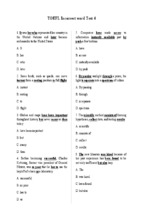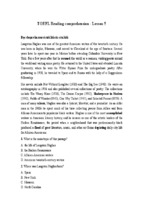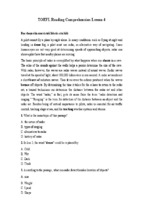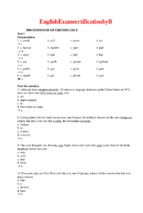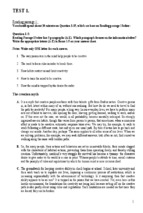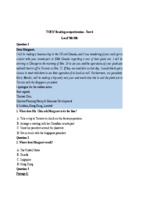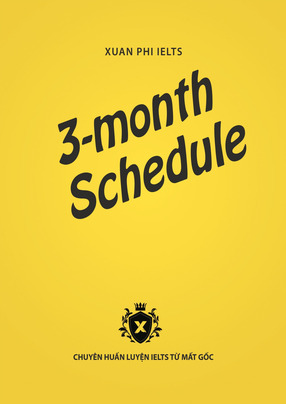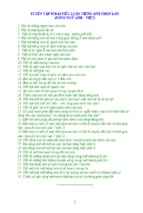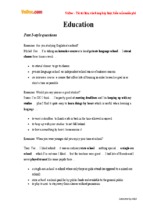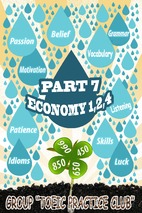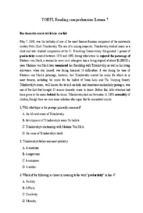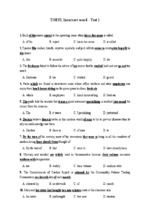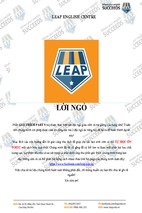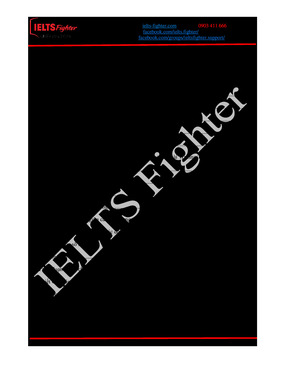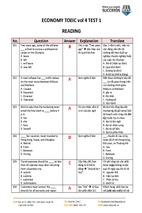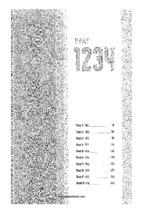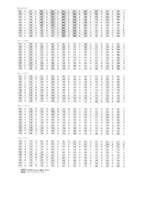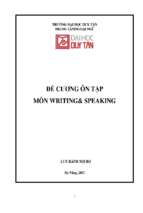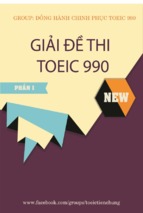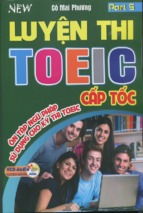Peterson’s
MASTER
TOEFL
READING
SKILLS
00_TOEFL Reading FM,i-x
1
7/29/06, 11:47
About Peterson’s
Peterson’s (www.petersons.com) is a leading provider of education information and advice, with books and
online resources focusing on education search, test preparation, and financial aid. Its Web site offers searchable
databases and interactive tools for contacting educational institutions, online practice tests and instruction, and
planning tools for securing financial aid. Peterson’s serves 110 million education consumers annually.
For more information, contact Peterson’s, 2000 Lenox Drive, Lawrenceville, NJ 08648; 800-338-3282;
or find us on the World Wide Web at www.petersons.com/about.
© 2007 Peterson’s, a Nelnet company
Portions of this book were previously published as Reading and Vocabulary Workbook for the TOEFL® Exam
Editor: Wallie Hammond; Production Editor: Bernadette Webster; Manufacturing Manager: Ivona Skibicki
ALL RIGHTS RESERVED. No part of this work covered by the copyright herein may be reproduced or used
in any form or by any means—graphic, electronic, or mechanical, including photocopying, recording, taping,
Web distribution, or information storage and retrieval systems—without the prior written permission of the
publisher.
For permission to use material from this text or product, submit a request online at www.petersons.com/permissions.
ISBN-13: 978-0-7689-2327-8
ISBN-10: 0-7689-2327-1
Printed in the United States of America
10 9 8 7 6 5 4 3 2 1 06 05 04
00_TOEFL Reading FM,i-x
2
7/29/06, 11:47
Petersons.com/publishing
Check out our Web site at www.petersons.com/publishing to see if there is any new information
regarding the test and any revisions or corrections to the content of this book. We’ve made sure
the information in this book is accurate and up-to-date; however, the test format or content may
have changed since the time of publication.
00_TOEFL Reading FM,i-x
3
7/29/06, 11:47
OTHER TITLES IN SERIES:
Peterson’s Master TOEFL Vocabulary
Peterson’s Master TOEFL Writing Skills
00_TOEFL Reading FM,i-x
4
7/29/06, 11:47
Contents
○
○
○
○
○
○
○
○
○
○
○
○
○
○
○
○
○
○
○
○
○
○
○
○
○
○
○
○
○
○
○
○
○
○
○
○
○
○
○
○
○
○
○
○
○
○
Before You Begin .................................................................................. vii
How This Book Is Organized ................................................................... vii
Special Study Features ............................................................................ vii
You’re Well on Your Way to Success ....................................................... viii
Give Us Your Feedback ........................................................................... viii
Top 10 Strategies to Raise Your Score ....................................................... ix
PART I TOEFL READING BASICS
Chapter 1: All About TOEFL Reading .................................................... 3
What Does the Reading Section Contain and How Long Does It Last? ..... 3
To Read or Not To Read .............................................................................. 4
Summing It Up .......................................................................................... 14
PART II DIAGNOSING STRENGTHS AND WEAKNESSES
Chapter 2: Practice Test 1: Diagnostic ............................................... 19
PART III TOEFL READING REVIEW
Chapter 3: Developing Reading Comprehension Skills ................... 33
Finding Main Ideas and Supporting Details ........................................... 33
Skimming for Specific Information .......................................................... 37
Making Inferences .................................................................................... 39
Understanding Advertisements ............................................................... 45
How Thoughts Are Related ....................................................................... 54
Understanding Contemporary Reading Passages ................................... 67
Reading History Textbooks ....................................................................... 79
Summing It Up ........................................................................................ 103
v
00_TOEFL Reading FM,i-x
5
7/29/06, 11:47
○
○
○
○
○
○
○
○
○
○
○
○
○
○
○
○
○
○
○
○
○
○
○
○
○
vi
○
○
○
○
○
○
Contents
○
○
○
○
○
○
○
○
○
○
○
○
○
○
○
○
○
○
○
○
○
○
○
○
○
○
○
○
○
○
○
○
○
○
○
○
○
○
○
○
○
○
○
○
○
○
○
○
○
○
○
○
○
○
○
PART IV TWO PRACTICE TESTS
Practice Test 2 ..................................................................................... 109
Practice Test 3 ..................................................................................... 123
PART V APPENDIXES
APPENDIX A: A Helpful Word List ....................................................... 137
APPENDIX B: Applying to Colleges and Universities in the U.S. ..... 177
www.petersons.com
○
○
○
○
○
○
○
○
○
○
○
○
○
○
○
○
○
○
○
○
○
○
○
○
○
○
○
○
○
○
○
○
○
○
○
○
○
○
○
○
○
○
○
○
○
○
○
○
○
○
○
○
○
○
○
○
○
○
○
○
○
○
○
○
○
○
○
○
○
○
○
○
○
○
○
○
○
○
○
○
○
○
○
○
○
○
○
○
○
○
○
○
○
6
○
00_TOEFL Reading FM,i-x
7/29/06, 11:47
○
Before You Begin
○
○
○
○
○
○
○
○
○
○
○
○
○
○
○
○
○
○
○
○
○
○
○
○
○
○
○
○
○
○
○
○
○
○
○
○
○
○
○
○
○
○
○
○
○
○
HOW THIS BOOK IS ORGANIZED
If you are preparing for any version of the TOEFL, you are not alone. Almost a
million people all over the world took the TOEFL last year. A high score on this
test is an essential step in being admitted to graduate or undergraduate
programs at almost all colleges and universities in North America. But
preparing for this test can be a difficult, often frustrating experience.
Peterson's Master TOEFL Reading Skills, used as a self-tutor, will help you
improve your reading skills. You’ll find:
•
•
Top 10 Strategies to Raise Your Score gives you test-taking strategies.
•
Part II provides the basic reading comprehension review. The reading
passages progress from relatively simple to relatively difficult as you
continue through the book. Various skills, such as finding the main idea and
supporting details, are reviewed.
•
Part III includes three additional practice reading tests. They will show
you how well you have mastered the reading skills presented in this book.
Part I provides a “mini” diagnostic test to determine your strengths and
weaknesses.
SPECIAL STUDY FEATURES
Peterson's Master TOEFL Reading Skills is designed to be user-friendly. To this
end, it includes features to make your preparation much more efficient.
Overview
The reading review chapter begins with a bulleted overview, listing the topics to
be covered in the chapter. This will allow you to quickly target the areas in which
you are most interested.
Note
Notes highlight critical information about improving your reading skills.
vii
00_TOEFL Reading FM,i-x
7
7/29/06, 11:47
○
○
○
○
○
○
○
○
○
○
○
○
○
○
○
○
○
○
○
○
○
○
○
○
○
viii
○
○
○
○
○
○
Before You Begin
○
○
○
○
○
○
○
○
○
○
○
○
○
○
○
○
○
○
○
○
○
○
○
○
○
○
○
○
○
○
○
○
○
○
○
○
○
○
○
○
○
○
○
○
○
○
○
○
○
○
○
○
○
○
○
○
Tip
Tips draw your attention to valuable concepts, advice, and shortcuts for tackling the
reading passages.
Summing it up
The review chapter ends with a point-by-point summary that captures the most
important concepts. They are a convenient way to review the chapter's key points.
Practice tests
The three practice tests, including the diagnostic test, are designed to help you prepare
with little anxiety.
YOU’RE WELL ON YOUR WAY TO SUCCESS
Remember that knowledge is power. By using Peterson's Master TOEFL Reading Skills
as a supplement to your other TOEFL test preparation, you will fine tune your reading
comprehension skills.
GIVE US YOUR FEEDBACK
Peterson's publishes a full line of resources to help guide you and your family through
the college admission process.
We welcome any comments or suggestions you may have about this publication and
invite you to complete our online survey at http://www.petersons.com/booksurvey. Or
you can fill out the survey at the back of this book, tear it out, and mail it to us at:
○
○
○
○
○
○
○
○
○
○
○
○
○
○
○
○
○
○
○
○
○
○
○
○
○
○
○
○
○
○
○
○
○
○
○
○
○
○
○
○
○
○
○
○
○
○
○
○
○
○
○
○
○
○
○
○
Your feedback will help us to provide personalized solutions for your educational
advancement.
www.petersons.com
○
○
○
○
○
○
○
○
○
○
○
○
○
○
○
○
○
○
○
○
○
○
○
○
○
○
○
○
○
○
○
○
○
○
○
○
Publishing Department
Peterson's
2000 Lenox Drive
Lawrenceville, NJ 08648
○
8
○
00_TOEFL Reading FM,i-x
7/29/06, 11:47
Before You Begin
○
○
○
○
○
○
○
○
○
○
○
○
○
○
○
○
○
○
○
○
○
○
○
○
○
○
○
○
○
○
○
ix
○
○
○
○
○
○
○
○
○
○
○
○
○
○
○
○
○
○
○
○
○
Top 10 Strategies
to Raise Your Score
1.
As with other sections of the TOEFL, be familiar with the directions and
examples so you can begin work immediately.
2.
For each passage, begin by briefly looking over the questions (but not the
answer choices). Try to keep these questions in mind during your reading.
3.
Scan passages to find and highlight the important facts and information.
4.
Read each passage at a comfortable speed.
5.
Answer the questions, referring to the passage when necessary.
6.
Eliminate answers that are clearly wrong or do not answer the question. If
more than one option remains, guess.
7.
Mark difficult or time-consuming answers so that you can come back to them
later if you have time.
8.
Timing is an important factor. Don’t spend more than 10 minutes on any one
passage and the questions about it.
9.
Concentration is another important factor. The reading section is one of the
longer sections of the test. Your practice and hard work will help you.
10. Relax the night before the exam.
www.petersons.com
00_TOEFL Reading FM,i-x
9
7/29/06, 11:47
○
○
○
○
○
○
○
○
○
○
○
00_TOEFL Reading FM,i-x
10
7/29/06, 11:47
PART I
○
○
○
○
○
○
○
○
○
○
○
○
○
○
○
○
○
○
○
○
○
○
○
○
○
○
○
○
○
○
○
○
○
○
○
○
○
○
○
○
○
○
○
○
○
○
TOEFL READING BASICS
○
○
○
○
○
○
○
○
○
○
○
○
○
○
○
○
○
○
○
○
○
○
○
○
○
○
○
○
○
○
○
○
○
CHAPTER 1
01_TOEFL Reading Ch 1,1-14
1
○
○
○
○
○
○
○
○
○
○
○
○
○
○
○
○
○
○
○
○
○
○
○
○
○
○
○
○
○
○
All About TOEFL Reading
7/29/06, 11:46
○
○
○
○
○
○
○
○
○
○
○
○
○
○
○
○
○
○
01_TOEFL Reading Ch 1,1-14
2
7/29/06, 11:46
All About TOEFL
Reading
○
○
○
○
○
○
○
○
○
○
○
○
○
○
○
○
○
○
○
○
○
○
○
○
○
○
○
○
○
○
○
○
○
○
○
○
○
○
○
○
○
○
○
○
○
○
• What does the reading section contain and how long does
it last?
• To read or not to read
• Summing it up
WHAT DOES THE READING SECTION CONTAIN AND
HOW LONG DOES IT LAST?
The Reading section contains passages on a variety of subjects. Following each
passage are several questions about the passage. You will answer from 36 to 70
questions in this section, and you will have 60 to 100 minutes to read the
passages and answer the questions. Before you begin this section, you will be
shown how to answer the questions with the computer screen and mouse.
The reading passages are similar to the ones you will probably read and study
in North American universities and colleges. There are three important differences between the Reading section and the other sections of the exam:
•
The Reading section is not computer adaptive. When you answer question
number 1, the computer does not select a more difficult (or less difficult)
question for number 2.
•
In the Reading section, you are allowed to return to questions you have
already answered and can change your answers. You are also permitted to
skip a question and return to it later, which you can’t do in the other sections
of the exam.
•
You will see the Reading passage and the question on the monitor screen at
the same time. The Reading passage will appear on the left side of your
screen, and the questions will appear on the right side of the screen.
3
01_TOEFL Reading Ch 1,1-14
3
7/29/06, 11:47
○
○
○
○
○
○
○
○
○
○
○
○
○
○
○
○
○
chapter 1
OVERVIEW
○
○
○
○
○
○
○
○
4
○
○
○
○
○
○
PART I: TOEFL Reading Basics
○
○
○
○
○
○
○
○
○
○
○
○
○
○
○
○
○
○
○
○
○
○
○
○
○
○
○
○
○
○
○
○
○
○
○
○
○
○
○
○
○
○
○
○
○
○
○
○
○
○
○
○
○
○
○
○
TO READ OR NOT TO READ
You will not be scored on whether you read the entire passage. You will be scored on
whether you answer the question correctly. It is not only probable that you can answer
all questions correctly without reading the entire passage; it is imperative that you read
only what is necessary to answer the questions.
So that you do not underestimate the importance of this advice, it will be repeated:
○
○
○
○
○
○
○
○
○
○
○
○
○
○
○
○
○
○
○
Most questions will indicate which part of the reading passage is being asked about.
Work through each passage answering the questions, using the process we describe in
the following pages.
Read the First Sentence of Each Paragraph and the Last Sentence in
the Passage
In the following passage, read only the sentences in boldface.
(5)
The American composer, George Gershwin, was born in 1898 in Brooklyn,
New York, the son of Russian-Jewish immigrants. He began his musical
education at age 11, when his family bought a second-hand piano. The piano was not
bought for him, but for his older brother, Ira. However, George surprised everyone
when he played a popular song, which he had taught himself by following the keys on
a neighbor’s player piano, and his parents decided that George should receive lessons.
He studied piano with a famous music teacher at the time, Charles Hambitzer. He was
so impressed with Gershwin’s talent that he gave him lessons for free.
Gershwin dropped out of school at age 15 and earned a living by making
(10) piano rolls for player pianos and by playing in New York nightclubs. His
most important job in this period was his work as a song plugger, who promoted
interest in the sheet music of popular songs by playing and singing those songs in
stores. At that time, sheet-music sales were the measure of a song’s popularity, and
song pluggers had to work long hours for the music publishers who employed them.
(15) As a result of his hard work, Gershwin’s piano technique improved greatly, so
much so that, while still in his teens, Gershwin became known as one of the most
talented pianists in New York City. As a result, he worked as an accompanist for
popular singers and as a rehearsal pianist for Broadway musicals.
His knowledge of jazz and popular music grew quickly, and one of his
(20) songs was included in the Broadway musical The Passing Show of 1916.
George became friends to many prominent Broadway composers. He particularly
admired the music of Irving Berlin whom Gershwin called “America’s Franz
Schubert.” Jerome Kern, another Broadway composer, demonstrated to George
how popular music was inferior to material in Broadway shows. In 1919, enter(25) tainer Al Jolson performed Gershwin’s song Swanee in the musical Sinbad. The
song became a hit, and Gershwin became an overnight celebrity when his
song sold more than 2 million recordings and a million copies of sheet
music.
www.petersons.com
○
○
○
○
○
○
○
○
○
○
○
○
○
○
○
○
○
○
○
○
○
○
○
○
○
○
○
○
○
○
○
○
○
○
○
○
○
○
○
○
○
○
○
○
○
○
○
○
○
○
○
○
○
○
○
○
○
○
○
○
○
○
○
○
○
○
○
○
○
○
○
○
○
DO NOT READ THE ENTIRE PASSAGE BEFORE
YOU START ANSWERING THE QUESTIONS!
○
4
○
01_TOEFL Reading Ch 1,1-14
7/29/06, 11:47
Chapter 1: All About TOEFL Reading
○
○
○
○
○
○
○
○
○
○
○
○
○
○
○
○
○
○
○
○
○
○
○
○
○
○
○
○
○
○
○
○
○
○
○
○
5
○
○
○
○
○
○
○
○
○
○
○
○
○
○
○
○
○
○
○
○
○
○
○
○
○
○
○
○
○
○
○
○
○
○
TIP
Main idea questions
○
○
○
○
○
○
○
○
○
○
○
The correct answer is (C). By reading those four sentences in bold type,
you have not only saved yourself time, you have also learned what the
passage is about. In addition, you have gotten the information necessary
to answer the question.
○
○
○
(D) Musical training on Broadway did not prepare the Gershwins
for success.
○
○
(C) George Gershwin became a famous composer before he was 30.
○
○
(B) The Gershwins were school dropouts who became successes in
show business.
○
○
Which of the following statements best expresses the main idea of the
passage?
(A) Russian immigrants in America were all musical and creative.
○
○
○
After you have read the sentences in boldface type, answer the following question:
○
○
○
○
Questions About the Main Idea of the Passage
○
○
○
○
○
○
Vocabulary questions are found in the parts of the reading passage that will be
highlighted to correspond with a question. This is another reason why it is unnecessary
for you to read the entire passage. See the following examples:
○
○
○
○
Vocabulary Questions
○
○
○
○
○
○
○
○
○
○
○
○
○
○
○
○
○
Look at the word highlighted in the text. Click on the answer choice that is closest in
meaning to the words dropped out of .
○
○
Gershwin dropped out of school at age 15 and earned a living by
making piano rolls for player pianos and by playing in New
York nightclubs. His most important job in this period was his
work as a song plugger, who promoted interest in the sheet
music of popular songs by playing and singing those songs in
stores. At that time, sheet-music . . .
○
○
You will answer three kinds of vocabulary questions. In the first kind, you will see a
word or phrase highlighted in the text on the screen. This highlights the word or phrase
that is the subject of the question. Look at the example. You will see the passage and
the question on the monitor screen arranged this way:
○
○
○
○
Highlighted Words
○
○
(A) Graduated from college
○
○
(B) Stopped attending secondary school
○
○
○
(C) Scattered sheet music on the street
5
7/29/06, 11:47
○
○
01_TOEFL Reading Ch 1,1-14
○
○
○
○
○
○
www.petersons.com
○
○
○
○
○
○
○
○
(D) Dropped by his school frequently
are usually asked first.
○
6
○
○
○
○
○
○
PART I: TOEFL Reading Basics
○
○
○
○
○
○
○
○
○
○
○
○
○
○
○
○
○
○
○
○
○
○
○
○
○
○
○
○
○
○
○
○
○
○
○
○
○
○
○
○
○
○
○
○
○
○
○
○
○
○
○
○
○
○
○
○
“Dropped out of” is an idiomatic expression, and if you are not acquainted with it, you
can still figure out the correct answer by looking at the other words in the sentence. You
can do this by mentally removing the words “dropped out of” from the sentence and
reading the sentence this way:
Gershwin __________ school at age 15 and earned a living by
making piano rolls for player pianos and by playing in New York
nightclubs.
Then, you fill in the blank with a verb that completes the sentence so that it is logical
and grammatically correct. The other words in the sentences contain clues. Look at the
words:
school at age 15 and earned a living by making piano rolls for
player pianos and by playing in New York nightclubs.
A 15-year-old person who earns a living by playing in New York nightclubs is not likely
to stay in high school at the same time. So, you choose a word or words that will finish
the sentence correctly. It’s not important what the words are; they can even be words
in your native language. The word or phrase you came up with is probably “quit” or
“withdrew from.”
Then, you compare your word to the answer choices:
(A) Graduated from college
(B) Stopped attending secondary school
(C) Scattered sheet music on the street
(D) Dropped by his school frequently
The correct answer is (B). The answer closest in meaning to “quit” or
“withdrew from.” Choice (A) is incorrect, because college is not mentioned
in the sentence. Choice (C) is incorrect, because the sentence is not about
sheet music. Choice (D) is incorrect and a tricky one, because “dropped out”
is close in sound to “dropped by,” which means visited.
Highlighted Sentences
Another type of vocabulary question asks you to read a boldface sentence, and choose
the correct definition of the highlighted word or phrase in that sentence.
Gershwin dropped out of school at age 15 and earned a living by making piano
rolls for player pianos and by playing in New York nightclubs. His most
important job in this period was his work as a song plugger, who
promoted interest in the sheet music of popular songs by playing and
singing those songs in stores. At that time, sheet-music sales were the
measure of a song’s popularity, and song pluggers had to work long hours
for the music publishers who employed them.
www.petersons.com
○
○
○
○
○
○
○
○
○
○
○
○
○
○
○
○
○
○
○
○
○
○
○
○
○
○
○
○
○
○
○
○
○
○
○
○
○
○
○
○
○
○
○
○
○
○
○
○
○
○
○
○
○
○
○
○
○
○
○
○
○
○
○
○
○
○
○
○
○
○
○
○
○
○
○
○
○
○
○
○
○
○
○
○
○
○
○
○
○
○
○
○
○
6
○
01_TOEFL Reading Ch 1,1-14
7/29/06, 11:47
Chapter 1: All About TOEFL Reading
○
○
○
○
○
○
○
○
○
○
○
○
○
○
○
○
○
○
○
○
○
○
○
○
○
○
○
○
○
○
○
○
○
○
○
○
7
○
○
○
○
○
○
○
○
○
○
○
○
○
○
○
○
○
Look at the words “promoted interest in the sheet music” in the passage. Click on the
word or phrase in the bold text that the words refer to.
○
○
○
○
○
○
○
(A) Sheet music sales
○
○
(B) A song’s popularity
○
○
(C) Song plugger
○
○
○
○
On the computer screen, you will highlight those words and click them as your choice.
Which words would you choose?
○
○
○
○
(D) Music publishers
○
○
(A) Sheet music sales
○
○
(B) A song’s popularity
○
○
(C) Song plugger
○
○
○
○
The correct answer is (C). The highlighted words “who promoted
interest in sheet music” identify what song pluggers do.
○
○
○
○
(D) Music publishers
○
○
○
○
○
○
○
○
○
○
○
○
○
○
Look at the highlighted word. Click on the word or phrase in the bold text that the word
refers to.
○
○
However, George surprised everyone when he played a popular song, which he
had taught himself by following the keys on a neighbor’s player piano, and his
parents decided that George should receive lessons. He studied piano with a
famous music teacher at the time, Charles Hambitzer. He was so impressed with Gershwin’s talent that he gave him lessons for free.
○
○
Another kind of Reading question deals with pronouns. You will see a sentence in
boldface with a highlighted pronoun, and you will be asked to identify the noun that the
highlighted pronoun refers to. Look at the example:
○
○
○
○
Pronouns
○
○
(A) Piano
○
○
(B) Charles Hambitzer
○
○
(C) The Time
7
7/29/06, 11:47
○
○
○
○
○
○
○
○
01_TOEFL Reading Ch 1,1-14
○
○
○
○
○
○
www.petersons.com
○
○
○
○
○
○
○
○
○
○
○
The correct answer is (B). The pronoun “he” refers to a person, not to a
thing (“piano” and “time” are things). “He” also does not refer to Gershwin,
because Gershwin did not give lessons to himself, so “he” must refer to
Charles Hambitzer.
○
○
○
○
(D) Gershwin
○
○
○
○
○
○
○
○
○
○
○
○
○
8
○
○
○
○
○
○
PART I: TOEFL Reading Basics
○
○
○
○
○
○
○
○
○
○
○
○
○
○
○
○
○
○
○
○
○
○
○
○
○
○
○
○
○
○
○
○
○
○
○
○
○
○
○
○
○
○
○
○
○
○
○
○
○
○
○
○
○
○
○
○
Detail Questions
You will have to answer detail questions at least twice per reading passage. In these
types of questions, you are asked about specific information in the text. First, read the
question to find out what information you have to find. Then, search for it in the text.
(5)
The American composer, George Gershwin, was born in 1898 in Brooklyn, New
York, the son of Russian-Jewish immigrants. He began his musical education at
age 11, when his family bought a second-hand piano. The piano was not bought for
him, but for his older brother, Ira. However, George surprised everyone when he
played a popular song, which he had taught himself by following the keys on a
neighbor’s player piano, and his parents decided that George should receive
lessons. He studied piano with a famous music teacher at the time, Charles
Hambitzer. He was so impressed with Gershwin’s talent that he gave him lessons
for free.
○
○
○
○
○
○
○
○
○
○
○
○
○
○
○
○
○
○
○
○
○
○
○
○
○
○
○
○
○
○
○
○
○
According to the passage, who did the Gershwin parents buy the piano for?
(A) George Gershwin
○
○
(B) Charles Hambitzer
○
○
(C) Other Russian immigrants
○
○
○
(D) Ira Gershwin
Look for the Important Words
Detail questions contain important words that will lead you to the answer. They are not
words such as “George Gershwin” or “composer.” They are words that specify the
information that will answer the question for you.
In the question, the words “buy the piano” are the most important words to help you find
the answer. Instead of reading the entire passage, scan the passage for those words. You
find it at the end of the second sentence and see that the correct answer is (D).
Look at the next example:
(5)
The American composer, George Gershwin, was born in 1898 in Brooklyn, New
York, the son of Russian-Jewish immigrants. He began his musical education at
age 11, when his family bought a second-hand piano. The piano was not bought for
him, but for his older brother, Ira. However, George surprised everyone when he
played a popular song, which he had taught himself by following the keys on a
neighbor’s player piano, and his parents decided that George should receive
lessons. He studied piano with a famous music teacher at the time, Charles
Hambitzer. He was so impressed with Gershwin’s talent that he gave him lessons
for free.
www.petersons.com
○
○
○
○
○
○
○
○
○
○
○
○
○
○
○
○
○
○
○
○
○
○
○
○
○
○
○
○
○
○
○
○
○
○
○
○
○
○
○
○
○
○
○
○
○
○
○
○
○
○
○
○
The correct answer is (D). In lines 3–4 above, the passage states that
Gershwin’s parents bought the piano for George’s brother Ira.
○
8
○
01_TOEFL Reading Ch 1,1-14
7/29/06, 11:47
Chapter 1: All About TOEFL Reading
○
○
○
○
○
○
○
○
○
○
○
○
○
○
○
○
○
○
○
○
○
○
○
○
○
○
○
○
○
○
○
○
○
○
○
○
9
○
○
○
○
○
○
○
○
○
○
○
○
○
○
○
○
○
According to the passage, why did George’s piano teacher give him lessons
for free?
(A) His parents were too poor to pay for the lessons.
○
○
○
○
○
○
○
○
○
○
○
○
○
○
○
○
○
○
○
○
DO NOT READ THE ENTIRE PASSAGE BEFORE
YOU START ANSWERING THE QUESTIONS!
○
○
Once again, repeat to yourself the most important strategy of answering questions in
the reading section:
○
○
○
The correct answer is (B). The most important words in the question are
“lessons for free.” When you scan for those words, you will find them in the
last sentence of the paragraph.
○
○
○
(D) Popular music was more important than classical music.
○
○
(C) Famous piano teachers never received money from their
students.
○
○
○
(B) The teacher was impressed with George’s talent.
○
○
○
Questions with Except and Not
○
○
○
○
All of the following are mentioned as members of the French Impressionist
group EXCEPT
(A) Edgar Dégas.
○
○
○
○
○
The following is an example of “Except/Not” questions:
○
○
○
(B) Camille Pissaro.
○
○
(C) Rembrandt van Rijn.
9
7/29/06, 11:47
○
○
○
○
○
○
○
○
○
○
○
○
○
○
○
○
○
○
○
01_TOEFL Reading Ch 1,1-14
○
○
○
○
○
○
www.petersons.com
○
○
○
(5)
The American composer, George Gershwin, was born in 1898 in Brooklyn, New
York, the son of Russian-Jewish immigrants. He began his musical education at
age 11, when his family bought a second-hand piano. The piano was not bought for
him, but for his older brother, Ira. However, George surprised everyone when he
played a popular song, which he had taught himself by following the keys on a
neighbor’s player piano, and his parents decided that George should receive
○
○
These kinds of questions will be asked at least four times per passage. Look at the
following example:
○
○
○
Whenever you see this kind of question, remember that the answer is the one that is
different from the others. Sometimes an answer has nothing to do with the main topic.
In the above example, choice (C) might have been “Honore de Balzac,” who was French
but not a painter.
○
○
○
In this question, you look for the answer that names a painter who is NOT
a French Impressionist. In this case, it is choice (C), Rembrandt van Rijn.
○
○
○
○
(D) Mary Cassat.
○
○
○
○
○
○
○
○
○
○
○
○
○
10
○
○
○
○
○
○
PART I: TOEFL Reading Basics
○
○
○
○
○
○
○
○
○
○
○
○
○
○
○
○
○
○
○
○
○
○
○
○
○
○
○
○
○
○
○
○
○
○
○
○
○
○
○
○
○
○
○
○
○
○
○
○
○
○
○
○
○
○
○
○
(10)
(15)
(20)
(25)
lessons. He studied piano with a famous music teacher at the time, Charles
Hambitzer. He was so impressed with Gershwin’s talent that he gave him lessons
for free.
Gershwin dropped out of school at age 15 and earned a living by making piano
rolls for player pianos and by playing in New York nightclubs. His most important
job in this period was his work as a song plugger, who promoted interest in the
sheet music of popular songs by playing and singing those songs in stores. At that
time, sheet-music sales were the measure of a song’s popularity, and song pluggers
had to work long hours for the music publishers who employed them. As a result
of his hard work, Gershwin’s piano technique improved greatly, so much so that,
while still in his teens, Gershwin became known as one of the most talented
pianists in New York City. As a result, he worked as an accompanist for popular
singers and as a rehearsal pianist for Broadway musicals.
His knowledge of jazz and popular music grew quickly, and one of his songs was
included in the Broadway musical The Passing Show of 1916. George became
friends to many prominent Broadway composers. He particularly admired the
music of Irving Berlin whom Gershwin called “America’s Franz Schubert.” Jerome
Kern, another Broadway composer, demonstrated to George how popular music
was inferior to material in Broadway shows. In 1919, entertainer Al Jolson
performed Gershwin’s song Swanee in the musical Sinbad. The song became a hit,
and Gershwin became an overnight celebrity when his song sold more than 2
million recordings and a million copies of sheet music.
All of the following are reasons that George Gershwin became a success
while he was young EXCEPT
(A) He studied piano with a famous teacher.
(B) He learned about jazz and popular music while he worked as a
song plugger.
(C) He graduated from high school when he was only 15.
(D) He worked as an accompanist for popular singers in New York.
The correct answer is (C). To answer this question correctly, you have
to determine the time period of each answer. In the text, in what order were
the answers stated? If you scan the passage you will see that the order is
(A), (C), (B), and (D).
Choices (A) and (C) appear in the first paragraph, where you read that
Gershwin studied with a famous teacher, which is the statement in choice
(A). You also read that Gershwin’s parents bought a piano for his brother,
which means that Gershwin’s parents did NOT give him a piano.
Choices (B) and (D) give reasons why Gershwin became a success while he
was young.
www.petersons.com
○
○
○
○
○
○
○
○
○
○
○
○
○
○
○
○
○
○
○
○
○
○
○
○
○
○
○
○
○
○
○
○
○
○
○
○
○
○
○
○
○
○
○
○
○
○
○
○
○
○
○
○
○
○
○
○
○
○
○
○
○
○
○
○
○
○
○
○
○
○
○
○
○
○
○
○
○
○
○
○
○
○
○
○
○
○
○
○
○
○
○
○
○
10
○
01_TOEFL Reading Ch 1,1-14
7/29/06, 11:47
- Xem thêm -

